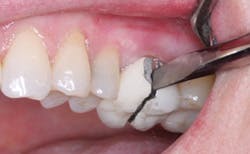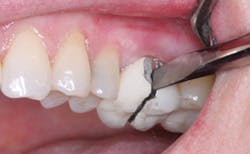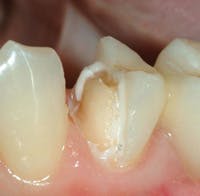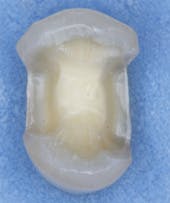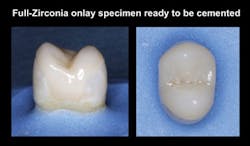Is socket grafting standard of care?
Gordon J. Christensen, DDS, MSD, PhD
Q
One of my dentist friends shared this situation with me. Recently, a patient for whom he had taken out some teeth challenged his treatment. He had not grafted the extraction sockets. The patient consulted with another dentist about the situation and was convinced by the second dentist that grafting sockets after tooth extraction should have been done. The patient did not know why my friend did not do socket grafting on him. The result is a potential lawsuit. I know that grafting is not commonly done. What is your recommendation for this frustrated dentist?
A
For many years, I’ve advised dentists who attend my continuing education courses to graft at least the extraction sites in the smile zone. To my dismay, on returning to those same groups, few dentists have actually incorporated socket grafting into their normal practice repertoire, in spite of the value of the procedure.
Let’s observe some of the characteristics of socket grafting and see if we can determine why most dentists shun this procedure.
They are unfamiliar with the value of the procedure. It has been my observation that most dentists are not taught the socket grafting procedure in school, and do not seek education on the procedure after school. As a result, they do not suggest grafting to their patients as they remove teeth. Usually, the teeth are removed, the bone and soft tissue shrink significantly over a period of months, and the subsequent implant placement or fixed prosthesis placement is esthetically and/or functionally compromised.
The overhead cost of grafting materials and related products is high (see cost estimates below). The average cost for enough grafting material for one socket (about ½ cc) is around $100. Some grafting materials require a membrane to avoid soft tissue ingrowth into the socket for another $100. However, this cost can be reduced by using some satisfactory grafting materials (examples below), and by using a low-cost collagen plug for about $10, thus avoiding the membrane. Sutures are another few dollars. The cost of the extraction and graft is somewhat formidable to many patients. When the cost of grafting ($493) is added to the average fee of $147 for a routine extraction, many patients are not convinced of the value of the procedure for $640. The summary of average ADA reported numbers and typical costs from manufacturers follows. The typical profit must have the ongoing office overhead deducted:
- Extraction (ADA D7140) $147
- Total for graft (ADA D7953) $493
- Gross revenue for extraction and graft ~$640
- Minus material costs
- Grafting material ~$100
- Membrane ~$100
- Suture ~$8
- Material cost total ~$208
- Gross profit (must still subtract office overhead) ~$432
Lack of third-party payment for grafting procedures. Some dental benefit plans do not pay for socket grafting. Since most dental patients have some type of benefit plan, the lack of payment by some benefit companies can make patients question the value of the procedure. Additionally, when asked to pay for the procedure themselves, most patients need significant persuasive education to accept it.
Patient concern about the origin of the grafting materials. Some patients object to the use of human or animal bone grafts in spite of the great amount of research that states the safety of the grafting materials.
What can you do to influence patients to accept socket grafting?
Patient education. Most patients need to be convinced that socket grafting is not an unnecessary procedure, and that it is well worth the additional cost. Observe Fig. 1, which shows a young man who apparently had a central incisor removed in a traumatic manner without socket grafting. The defect is obvious, and it precludes adequate esthetic placement of a conventional diameter implant or esthetic placement of a pontic. The only solution for such unfortunate treatment is the necessary placement of an expensive and unpredictable graft, waiting for months for the graft to mature, and eventually placing an implant, abutment, and crown, or a fixed prosthesis to bridge the missing tooth gap.
Fig. 2 shows a situation in which a fixed prosthesis was apparently placed in spite of a significant bony and soft tissue defect in the right central incisor area. Patients cannot deny the unsightly results when they see such photos. If patients are shown photos of clinical situations in which grafting was not completed, which show the adverse effects of incorrect tooth removal and/or lack of grafting, most will agree to the cost of the socket grafting procedure.
Perfect your socket grafting technique. By incorporating the socket grafting procedure into your practice and accomplishing many grafts over a period of time, you will reduce the time involvement and uncertainty of the procedure, thus reducing the overhead for the procedure.
Reduce your fee for socket grafting. Socket grafting is neither a difficult nor time-consuming procedure. It requires only a few minutes, and can actually save time by reducing the time for proper blood clotting to occur. You can reduce your clinical fee by buying grafting material in quantity, which reduces the price considerably. Assuming you’re going to incorporate socket grafting into your practice, you will soon use significant quantities of the materials, and it will become desirable to buy the grafting materials in bulk. Use grafting materials that do not require an expensive membrane. I will discuss that below.
Example products for socket grafting
The following are example products. There are many other excellent products for socket grafting. I demonstrate all of these personally on PCC’s new socket grafting video (more information following).
- Atraumatic tooth removal. Luxator from JS Dental, and/or Proximator from Karl Schumacher.
- Grafting material. Allograft (human bone), Puros Demineralized Bone Matrix Putty with chips from Zimmer.
- Collagen plug to place over graft. CollaPlug from Zimmer or OraPlug from Salvin.
- Suture. Vicryl from Ethicon Inc.
Practical Clinical Courses has a new video, “Socket Preservation and Bone Grafting” Video V4350. It is available by going to www.pccdental.com or calling PCC at 800-223-6569.
Summary
To answer your question very simply, socket grafting is not yet “standard of care,” but in my opinion it certainly should be, at least in the smile zone. Why your friend did not accomplish socket grafting for his patient is unknown, but I have discussed several potential reasons. I suggest that all dentists should accomplish this simple technique of socket grafting. The technique is especially important in areas of the mouth where bone and soft tissue shrinkage will not allow adequate implant placement, or would necessitate placing an unsightly pontic if an implant is not placed. Using products and concepts that potentially decrease the cost of socket grafting are discussed and identified for you.
Gordon Christensen, DDS, MSD, PhD, is a practicing prosthodontist in Provo, Utah. He is the founder and director of Practical Clinical Courses, an international continuing-education organization initiated in 1981 for dental professionals. Dr. Christensen is a cofounder (with his wife, Rella) and senior consultant of CLINICIANS REPORT (formerly Clinical Research Associates).
In this monthly feature, Dr. Gordon Christensen addresses the most frequently asked questions from Dental Economics® readers. If you would like to submit a question to Dr. Christensen, please send an email to [email protected].
Past DE Issues
